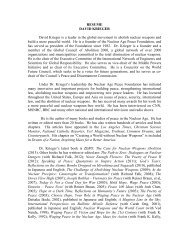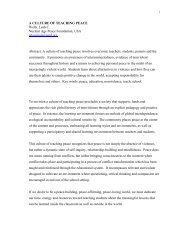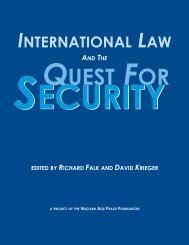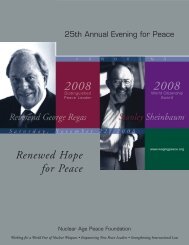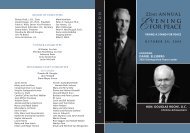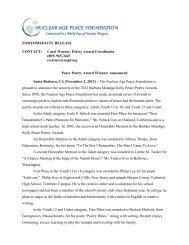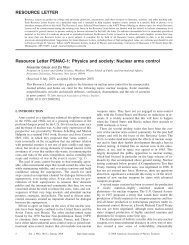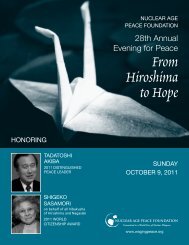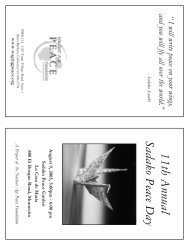Volume 15 - 1 edits.qxd - Nuclear Age Peace Foundation
Volume 15 - 1 edits.qxd - Nuclear Age Peace Foundation
Volume 15 - 1 edits.qxd - Nuclear Age Peace Foundation
- No tags were found...
Create successful ePaper yourself
Turn your PDF publications into a flip-book with our unique Google optimized e-Paper software.
Course for US <strong>Nuclear</strong> Policy2004 International Law Symposium Participants.Front Row (left to right): Prof. Richard Falk, Dr. Randall Forsberg, Hon. Douglas Roche, Daniel Ellsberg, Prof. George Lakoff, Dr. DavidKrieger, Dr. Philip E. Coyle III, Dr. Bennett Ramberg. Back Row (left to right): Justine Wang, Prof. Adil Najam, Dr. Brent Blackwelder, Dr. Michael Flynn, Jackie Cabasso, Dr. JohnBurroughs, Michele Boyd, Dr. Tom Reifer, Rob Stuart, Alice Slater, Nichole Riggs, Prof. Thomas G. Plate, Carah Ong. Photo by Rick A. Carter.“It is paradoxical that just when the voice of the public is most neededto move governments on nuclear disarmament, it is most difficultto awaken the public. The public is by no means uncaring aboutwar; they just do not see the connection between retention of nuclearweapons and the likelihood of mass destruction ahead....“The empowerment of peoples is needed to address the dominance ofshort-term interests and lack of transparency where the planet’s fateis being decided by what to do about nuclear weapons.”- Hon. Douglas Roche“When it comes to nuclear weapons, we are witnessing a revival ofthe ‘Hiroshima Temptation,’ the absence of an inhibiting restraintarising from the prospect of retaliation. This is part of a larger, dangerouscondition in which the US is inclined to use force to upholdits position of global dominance, given its decline in economic anddiplomatic leverage. The US has dismissed international law – fromthe failure to observe the Geneva Conventions with respect to prisonersin Guantanamo and Abu Ghraib to the defiant attitude ofthe White House with respect to recourse to wars of choice....“The only hope for charting a new course for US nuclear policy is torestore realism in the US leadership. US leadership must also makea self-interested repudiation of the ‘Hiroshima Temptation’ andrebuild a cooperative multi-polar world order. US leadership will begreatly enhanced by the rejection of nuclearism, the only clear pathto non-proliferation.”- Professor Richard Falk“If the planet were a country, it would be a poor, divided, degraded,insecure, poorly governed, country of apartheid, as well as a thirdworld country. We need to understand nuclearism today in a feudalcontext. South Asia contains 40% of the world’s poor and one-halfof all illiterates in the world. 260 million people live without basichealth facilities; 337 million do not have safe drinking water; 400million go hungry and 500 million people live below the poverty line.Alas, South Asia is the most militarized area of the world. Spendingmoney for military purposes has a real cost to the security of people.There is a new politics of nuclearism. <strong>Nuclear</strong> weapons are the poorman’s weapon. There is no argument one can make to disarm if theUS does not take the lead.”- Dr. Adil Najam“We are challenged to do something that has never been fully donebefore: to eliminate a type of weapon that may appear to its possessorsas providing political or military advantage. If we can help citizensand leaders alike to use their imaginations to project the likelihoodand consequences of the further use of these weapons, we maybe able to navigate a new course in US nuclear policy, leading to thecontrol and elimination of these weapons. We must engage this issueas if our very future and that of our children and grandchildrendepended upon it. It does.”- David Krieger<strong>Nuclear</strong> <strong>Age</strong> <strong>Peace</strong> <strong>Foundation</strong> 7



